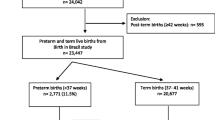Abstract
Objective: The Halifax County Preterm Birth Prevention Project was designed to evaluate the effectiveness of a population-based preterm birth (PTB) prevention program in Nova Scotia from January 1995 through June 1997 (n = 10,326). Methods: Preterm birth rates, adjusted for risk status and maternal age, were evaluated over time in Halifax County and compared to non-Halifax County parturients in Nova Scotia. Physician participation was evaluated by means of a mailed survey. Results: There was no appreciable change in the overall (<37 weeks) or early (<34 weeks) PTB rates within or outside Halifax County during the intervention period compared to the preintervention period. Although not significant, the very (<30 weeks) PTB rate in Halifax County decreased by 40% from 0.53 to 0.32%, while outside Halifax County it remained stable (0.43–0.42%). There was a statistically significant decrease in early and very PTB associated with spontaneous labour, as well as an apparent shift in the timing of delivery from very preterm to preterm (≥30 weeks). Participation among responding physicians was greater for high-risk than low-risk women, but full compliance with project recommendations was low. Conclusion: The overall ineffectiveness of the Halifax County Preterm Birth Prevention Project may reflect the reluctance of practitioners to fully incorporate the recommended prevention strategies into their practice. However, such interventions may reduce the risk of spontaneous early preterm birth.
Similar content being viewed by others
REFERENCES
Berkowitz GS, Papiernik E. Epidemiology of preterm birth. Epidemiol Rev 1993;15:414–43.
Ng E, Wilkins R. Maternal demographic characteristics and rates of low birth weight in Canada, 1961-90. Health Rep 1994;6:241–52.
Joseph KS, Kramer MS, Marcoux S, Ohlsson A, Wen SW, Allen A, Platt R. Determinants of preterm birthrates in Canada from 1981 through 1983 and from 1992 through 1994. N Engl J Med 1998;339;1434–9.
Higby K, Xenakis EMJ, Pauerstein CJ. Do tocolytic agents stop preterm labour? A critical and comprehensive review of efficacy and safety. Am J Obstet Gynecol 1993;168:1247–56.
The Canadian Preterm Labour Investigators Group. Treatment of preterm labour with the beta-adrenergic agonist ritodrine. N Engl J Med 1992;327:308–12.
Murphy PA. Preterm birth prevention programs: A critique of current literature. J Nurse-Midwifery 1993;38:324–35.
Main DM, Gabbe SG, Richardson D, Strong S. Can preterm births be prevented? Am J Obstet Gynecol 1985;151:892–8.
Konte JM, Creasy RK, Laros RK. California north coast preterm birth prevention project. Obstet Gynecol 1988;71:727-30.
Mueller-Heubach E, Reddick D, Bennett B, Bent R. Preterm birth prevention: Evaluation of a prospective controlled randomized trial. Am J Obstet Gynecol 1989;160:1172–8.
Goldenberg RL, Davis RO, Copper RL, Corliss DK, Andrews JB, Carpenter AH. The Alabama preterm birth prevention project. Obstet Gynecol 1990;75:933–9.
Collaborative Group on Preterm Birth Prevention. Multicentre randomized controlled trial of a preterm birth prevention program. Am J Obstet Gynecol 1993;169:352–66.
Hobel CJ, Ross MG, Bemis RL, Bragonier JR, Nessim S, Sandhu M, Bear MB, Mori B. TheWest Los Angeles preterm birth prevention project I: Program impact on high-risk women. Am J Obstet Gynecol 1994;170:54–62.
Moore ML, Meis PJ, Ernest JM, Wells HB, Zaccaro DJ, Terrell T. A randomized trial of nurse intervention to reduce preterm and low birth weight births. Obstet Gynecol 1998;91:656–61.
Hueston WJ, Knox MA, Eilers G, Pauwels J, Lonsdorf D. The effectiveness of preterm birth prevention educational programs for high-risk women: A meta-analysis. Obstet Gynecol 1995;86:705–12.
Papiernik E, Bouyer J, Dreyfus J, Collin D, Winisdorfer G, Guegon S, Lecomte M, Lazar P. Prevention of preterm births: A perinatal study in Hagauenau, France. Pediatrics 1985;76:154–8.
Herron MA, Katz M, Creasy RK. Evaluation of a preterm birth prevention program: Preliminary report. Obstet Gynecol 1982;59:452–6.
Goujon H, Papiernik E, Maine D. The prevention of preterm delivery through prenatal care: An intervention study in Martinique. Int J Gynaecol Obstet 1984;22:339–43.
Meis PJ, Ernest JM, Moore ML, Michielutte R, Sharp PC, Buescher PA. Regional program for prevention of premature birth in northwestern North Carolina. Am J Obstet Gynecol 1987;157:550–6.
Yawn BP, Yawn RA. Preterm birth prevention in a rural practice. JAMA 1989;262:230–3.
Fangman JJ, Mark PM, Pratt L, Conway KK, Healy ML, Oswald JW, Uden DL. Prematurity prevention programs: An analysis of successes and failures. Am J Obstet Gynecol 1994;170:744–50.
Statistics Canada. 1996 Census of Canada. Government of Nova Scotia, Department of Finance, Statistics Division, May 1998.
Armson BA, Dodds L. Prediction of preterm birth in a population of Canadian women. Int J Gynecol Obstet 1994;26 (Suppl. 2):93.
Stevens-Simon C, Orleans M. Low-birthweight prevention programs: The enigma of failure. Birth 1999;26:184–91.
Shiono PH, Klebanoffll MA. A review of risk-scoring for preterm birth. Clin Perinatol 1993;20:107–25.
Beukens P, Alexander S, Boutsen M, Blondel B, Kaminski M, Reid M. European Community Collaborative Study Group on Prenatal Screening. Randomized controlled trial of routine cervical examinations in pregnancy. Lancet 1994;344:841–3.
The Collaborative Home Uterine Monitoring Study Group. A multicenter randomized controlled trial of home uterine monitoring: Active versus sham device. Am J Obstet Gynecol 1995;173:1120–7.
Davies BL, Stewart PJ, Sprague AE, Niday PA, Nimrod CA, Dulberg CS. Education of women about the prevention of preterm birth. Can J Public Health 1998;89:260–3.
Lomas J, Anderson GM, Domnick Pierre K, Vayda E, Enkin MW, Hannah WJ. Do practice guidelines guide practice? The effectiveness of a consensus statement on the practice of physicians. N Engl J Med 1980;321:1306–11.
Gomez R, Romero R, Edwin SS, David C. Pathogenesis of preterm labour and preterm premature rupture of membranes associated with intra amniotic infection. Infec Dis Clin North Am 1997;11:135–76.
Moutquin JM, Milot-Roy V, Irion O. Preterm birth prevention: Effectiveness of current strategies. J Soc Obstet Gynecol Can 1996;18:571–88.
Author information
Authors and Affiliations
Corresponding author
Rights and permissions
About this article
Cite this article
Armson, B.A., Dodds, L., Cervin, C. et al. A Preterm Birth Prevention Project in Nova Scotia, Canada. Matern Child Health J 5, 189–197 (2001). https://doi.org/10.1023/A:1011300102132
Issue Date:
DOI: https://doi.org/10.1023/A:1011300102132




